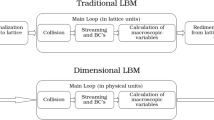Abstract
A class of lattice gas models are studied which are variants of the FCHC model. The aim is to achieve the highest possible Reynolds coefficient (inverse dimensionless viscosity) for efficient simulations of the three-dimensional incompressible Navier-Stokes equations. The models include an arbitrary number of rest particles and violation of semi-detailed balance. Within the framework of the Boltzmann approximation exact expressions are obtained for the Reynolds coefficients. The minimization of the viscosity is done by solving a Hitchcock-type optimization problem for the fine tuning of the collision rules. When the number of rest particles exceeds one, there is a range of densities at which the viscosity takes negative values. Various optimal models with up to 26 bits per node have been implemented on a CRAY-2 and their true transport coefficients have been measured with good accuracy. Fairly large discrepancies with Boltzmann values are observed when semi-detailed balance is violated; in particular, no negative viscosity is obtained. Still, the best model has a Reynolds coefficient of 13.5, twice that of the best previously implemented model, and thus is about 16 times more efficient computationally. Suggestions are made for further improvements. It is proposed to use models with very high Reynolds coefficients for sub-grid-scale modeling of turbulent flows.
Similar content being viewed by others
References
U. Frisch, B. Hasslacher, and Y. Pomeau, Lattice gas automata for the Navier-Stokes equation,Phys. Rev. Lett. 56:1505–1508 (1986).
J. Hardy, Y. Pomeau, and O. de Pazzis, Time evolution of a two-dimensional model system. I. Invariant states and time correlation functions,J. Math. Phys. 14:1746–1759 (1973).
U. Frisch, D. d'Humiéres, B. Hasslacher, P. Lallemand, Y. Pomeau, and J.-P. Rivet, Lattice gas hydrodynamics in two and three dimensions,Complex Systems 1:649–707 (1987) [reprinted inLecture Notes on Turbulence, I. R. Herring and J. C. McWilliams, eds. (World Scientific, 1989), pp. 297–371].
S. Wolfram, Cellular automaton fluids 1: Basic theory,J. Stat. Phys. 45:471–526 (1986).
D. d'Humiéres and P. Lallemand, Numerical simulations of hydrodynamics with lattice gas automata in two dimensions,Complex Systems 2:599–632 (1987).
D. d'Humiéres, P. Lallemand, and U. Frisch, Lattice gas models for 3-D hydrodynamics,Europhys. Lett. 2:291–297 (1986).
J.-P. Rivet, M. Hénon, U. Frisch, and D. d'Humiéres, Simulating fully three-dimensional external flow by lattice gas methods,Europhys. Lett. 7:231–236 (1988).
M. Hénon, Isometric collision rules for the four-dimensional FCHC lattice gas,Complex Systems 1:475–494 (1987).
J.-P. Rivet, Simulation d'écoulements tri-dimensionnels par la méthode des gaz sur réseaux: premiers résultats,C. R. Acad. Sci. Paris II 305:751–756 (1987).
M. Hénon, Optimization of collision rules in the FCHC lattice gas, and addition of rest particles, inDiscrete Kinetic Theory, Lattice Gas Dynamics and Foundations of Hydrodynamics, R. Monaco, ed. (World Scientific, 1989), pp. 146–159.
J.-P. Rivet, Hydrodynamique par la méthode des gaz sur réseaux, Thèse, Université de Nice (1988).
B. Dubrulle, Method of computation of the Reynolds number for two models of lattice gas involving violation of semi-detailed balance,Complex Systems 2:577–609 (1988).
M. Hénon, Viscosity of a lattice gas,Complex Systems 1:763–789 (1987).
J. A. Somers and P. C. Rem, The construction of efficient collision tables for fluid flow computations with cellular automata, inCellular Automata and the Modelling of Complex Systems (Springer, 1989).
S. A. Orszag and V. Yakhot, Reynolds number scaling of cellular automaton hydrodynamics,Phys. Rev. Lett. 56:1691–1693 (1986).
D. H. Rothman, Negative-viscosity lattice gases,J. Stat. Phys. 56:517–524 (1989).
H. Chen, S. Chen, G. D. Doolen, Y. C. Lee, and H. Rose, Multithermodynamic phase lattice gas automata incorporating interparticle potentials,Phys. Rev. A 40:2850–2853 (1989).
C. H. Papadimitriou and K. Steiglitz,Combinatorial Optimization: Algorithms and Complexity (Prentice-Hall, Englewood Cliffs, New Jersey, 1982).
U. Frisch, Où en est la turbulence développée?,Phys. Scripta 9:137–146 (1985).
S. Zaleski, Weakly compressible fluid simulations at high Reynolds numbers, inDiscrete Kinetic Theory, Lattice Gas Dynamics and Foundations of Hydrodynamics, R. Monaco, ed. (World Scientific, 1989), pp. 384–394.
G. R. MacNamara and G. Zanetti, Use of the Boltzmann equation to simulate lattice-gas automata,Phys. Rev. Lett. 61:2332–2335 (1988).
F. J. Higuera, Lattice gas simulation based on the Boltzmann equation, inDiscrete Kinetic Theory, Lattice Gas Dynamics and Foundations of Hydrodynamics, R. Monaco, ed. (World Scientific, 1989), pp. 162–177.
A. Patera, Private communication (1988).
Author information
Authors and Affiliations
Rights and permissions
About this article
Cite this article
Dubrulle, B., Frisch, U., Hénon, M. et al. Low-viscosity lattice gases. J Stat Phys 59, 1187–1226 (1990). https://doi.org/10.1007/BF01334747
Received:
Revised:
Issue Date:
DOI: https://doi.org/10.1007/BF01334747




